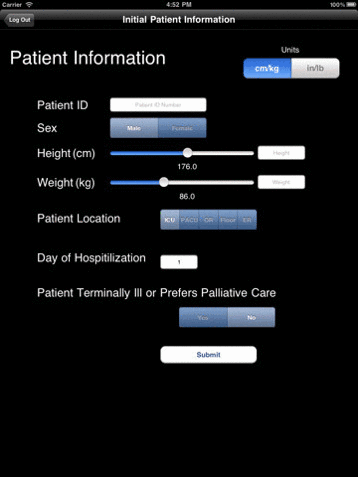When a patient comes into the E.R. with a lung problem, doctors usually put them on a ventilator. Unfortunately, this procedure helps some patients, but hurts others. Doctors have difficulty predicting which will be the case, due to a lack of data on risk factors. A predictive model was recently developed to solve this problem, but the calculations require more time and information than E.R. doctors usually have.
Enter Raquel Bartz, an emergency room doctor at Duke Hospital. She envisioned an iPad application where doctors and family members could input the necessary medical information, and the app would spit out the treatment protocol for a particular patient. Bartz turned to Richard Lucic and Robert Duvall’s Software for Mobile Devices class (COMPSCI 196) to make her idea a reality.
The result? An application called eCLIP, developed by students last Fall and available now in iTunes’ App Store. (See photos at left)
eCLIP is one of five applications created by students during the two semesters COMPSCI 196 has been offered. Lucic and Duvall described the course — and its various student-produced applications — at last week’s Visualization Friday Forum, sponsored by the Visualization Studies Initiative (http://visualstudies.duke.edu/) and Duke’s computer science department.
“We’re trying to teach students about the mobile app world,” Lucic said. “In addition, we’re trying to teach students about the software development process, from conception of an idea to delivering a product to a client.”
Lucic emphasized the importance of teamwork, as well as the value of visual design skills for increasing a product’s appeal. Furthermore, user testing is a critical step for identifying problems.
This semester, nine clients pitched their application ideas. Students voted for their favorite projects, and three were ultimately chosen:
- Ajay Patel, IT Manager in the Duke Cancer Center, wanted a way to track medical samples during processing and reduce human error
- Allison Besch, educational curator for the North Carolina Maritime Museum, wanted a fun, educational tool for teaching marine resource conservation to 4th graders
- Rachel Cook, Duke alumna and former futures trader, wanted an app to encourage microlending and bridge the gap between lenders and borrowers
Each client worked with a team of 3-4 students, and met with them every other week to discuss the team’s progress.
“A lot of students are learning how to code mobile apps for the first time, so there’s only 6-7 weeks of actual coding time,” Duvall said.
Despite the time crunch, students try to present a finished product to their clients by the end of the semester. But who keeps the app going after the course’s conclusion?
“What we’re trying to do is have the students provide enough documentation and write their code well enough that the app can be maintained by the client’s organization,” Lucic said. “Clients have been thrilled with the experience. I think we’ve done a superb job of meeting their needs, as much as you can in a one-semester course.”












